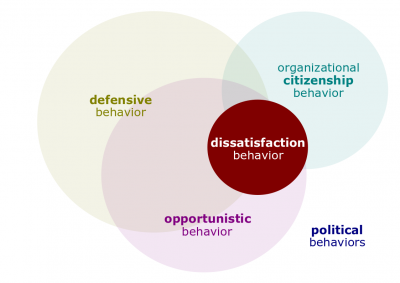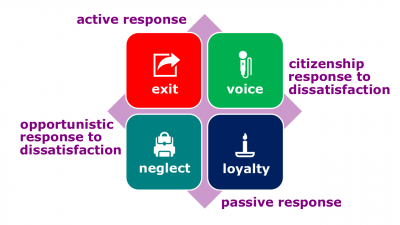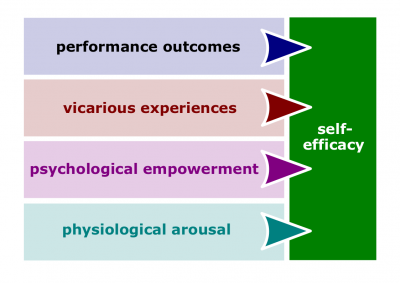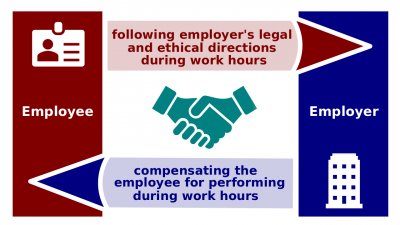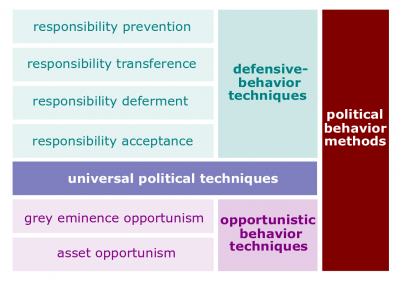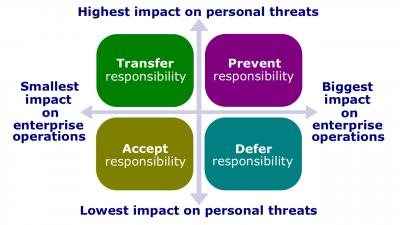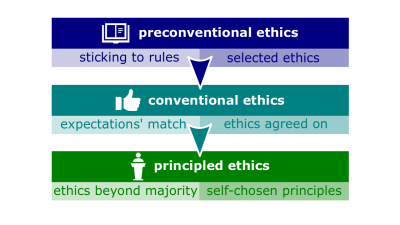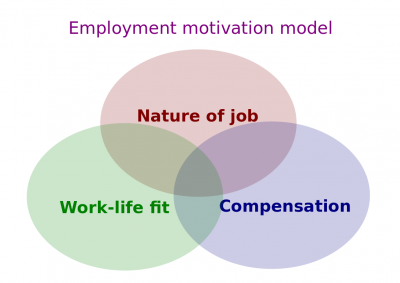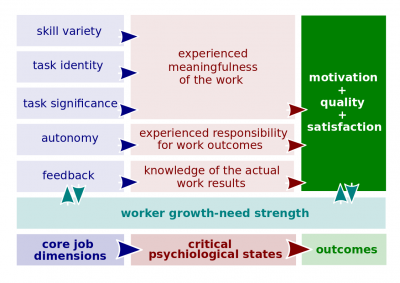Difference between revisions of "Talent Management Quarter"
(→Instruments) |
|||
| (3 intermediate revisions by the same user not shown) | |||
| Line 16: | Line 16: | ||
#'''[[Job satisfaction]]'''. (1) A positive feeling about one's job resulting from an evaluation of its characteristics; (2) An employee's general [[attitude]] toward her or his job resulting from the difference between positive and negative feelings. | #'''[[Job satisfaction]]'''. (1) A positive feeling about one's job resulting from an evaluation of its characteristics; (2) An employee's general [[attitude]] toward her or his job resulting from the difference between positive and negative feelings. | ||
#*[[Job dissatisfaction]]. A negative feeling about one's job resulting from an evaluation of its characteristics. | #*[[Job dissatisfaction]]. A negative feeling about one's job resulting from an evaluation of its characteristics. | ||
| − | #'''[[Professional ability]]'''. An individual's capacity to perform the various tasks in a job. | + | #'''[[Professional ability]]'''. An individual's [[capacity]] to perform the various tasks in a job. |
#*[[Reading skills]]. Skills that entail an understanding of written sentences and paragraphs in work-related documents. | #*[[Reading skills]]. Skills that entail an understanding of written sentences and paragraphs in work-related documents. | ||
#*[[Writing skills]]. Skills that entail communicating effectively in text as appropriate for the needs of the audience. | #*[[Writing skills]]. Skills that entail communicating effectively in text as appropriate for the needs of the audience. | ||
| Line 27: | Line 27: | ||
#[[File:Administrative-competence.png|400px|thumb|right|[[Administrative competence]]]]'''[[Administrative competence]]'''. [[Competence]] needed to undertake [[enterprise effort]]s. | #[[File:Administrative-competence.png|400px|thumb|right|[[Administrative competence]]]]'''[[Administrative competence]]'''. [[Competence]] needed to undertake [[enterprise effort]]s. | ||
#*[[Competence]]. The ability to do something successfully or efficiently. | #*[[Competence]]. The ability to do something successfully or efficiently. | ||
| − | #*[[Operational competence]] ([[technical competence]], [[technical skills]]). [[Knowledge, skills, and abilities]] needed to perform the most of jobs. That competence includes capacity to read, write, analyze, use computers, etc. | + | #*[[Operational competence]] ([[technical competence]], [[technical skills]]). [[Knowledge, skills, and abilities]] needed to perform the most of jobs. That competence includes [[capacity]] to read, write, analyze, use computers, etc. |
| − | #*[[Interpersonal competence]] ([[human competence]], [[interpersonal skills]], [[people skills]]). [[Knowledge, skills, and abilities]] needed to work with other people individually and in a group. That competence includes capacity to listen actively, communicate, understand other's motivation, etc. | + | #*[[Interpersonal competence]] ([[human competence]], [[interpersonal skills]], [[people skills]]). [[Knowledge, skills, and abilities]] needed to work with other people individually and in a group. That competence includes [[capacity]] to listen actively, communicate, understand other's motivation, etc. |
| − | #*[[Enterprise competence]] ([[organizational competence]], [[organizational skills]], [[conceptual competence]]). [[Knowledge, skills, and abilities]] needed to undertake [[enterprise effort]]s as well as to work in and with [[enterprise]]s. That competence includes capacity to navigate [[organization]]s and [[bureaucracy|bureaucraci]]es, plan resources, research for and execute [[regulatory compliance]], etc. | + | #*[[Enterprise competence]] ([[organizational competence]], [[organizational skills]], [[conceptual competence]]). [[Knowledge, skills, and abilities]] needed to undertake [[enterprise effort]]s as well as to work in and with [[enterprise]]s. That competence includes [[capacity]] to navigate [[organization]]s and [[bureaucracy|bureaucraci]]es, plan resources, research for and execute [[regulatory compliance]], etc. |
#[[File:Deductive-inductive.png|400px|thumb|right|[[Concept]] vs [[experiment]]]]'''[[Conceptual ability]]'''. The ability to think and to conceptualize about abstract and complex situations. | #[[File:Deductive-inductive.png|400px|thumb|right|[[Concept]] vs [[experiment]]]]'''[[Conceptual ability]]'''. The ability to think and to conceptualize about abstract and complex situations. | ||
#*[[Deductive reasoning]] ([[top-down logic]], [[deductive logic]], [[logical deduction]]). The process of reasoning from one or more statements called ''premises'' to reach one or more logically certain conclusions. | #*[[Deductive reasoning]] ([[top-down logic]], [[deductive logic]], [[logical deduction]]). The process of reasoning from one or more statements called ''premises'' to reach one or more logically certain conclusions. | ||
| Line 83: | Line 83: | ||
#'''[[Employment agent]]'''. One that runs an employment agency or as a business finds jobs for those seeking them or people to fill jobs that are open. | #'''[[Employment agent]]'''. One that runs an employment agency or as a business finds jobs for those seeking them or people to fill jobs that are open. | ||
#*[[Agent of a performer]] ([[business manager of a performer]], [[performer's agent]], [[performer's representative]], [[talent agent]], [[talent manager]]). A professional who represents and promotes performers especially artists and athletes in dealings with current or prospective employers. An incumbent of this role may handle contract negotiation and other business matters for clients. | #*[[Agent of a performer]] ([[business manager of a performer]], [[performer's agent]], [[performer's representative]], [[talent agent]], [[talent manager]]). A professional who represents and promotes performers especially artists and athletes in dealings with current or prospective employers. An incumbent of this role may handle contract negotiation and other business matters for clients. | ||
| − | #'''[[Éminence grise]]''' ([[grey eminence]], [[grey cardinal]]). A powerful decision-maker or adviser who operates "behind the scenes", or in a non-public or unofficial capacity. | + | #'''[[Éminence grise]]''' ([[grey eminence]], [[grey cardinal]]). A powerful decision-maker or adviser who operates "behind the scenes", or in a non-public or unofficial [[capacity]]. |
===Methods=== | ===Methods=== | ||
| Line 134: | Line 134: | ||
#*[[Conventional level]]. The middle level of moral development in which a person's choice between right and wrong relies on maintaining expected standards and living up to the expectations of others, or, in other words, is cooperatively motivated. This ''level'' consists of two stages: (a) living up to what the people close to the person expect and (b) maintaining conventional order by fulfilling obligations to which the person agrees. | #*[[Conventional level]]. The middle level of moral development in which a person's choice between right and wrong relies on maintaining expected standards and living up to the expectations of others, or, in other words, is cooperatively motivated. This ''level'' consists of two stages: (a) living up to what the people close to the person expect and (b) maintaining conventional order by fulfilling obligations to which the person agrees. | ||
#*[[Principled level]]. The upper level of moral development in which a person's choice between right and wrong is based on the person's own moral values apart from authority of the groups to which he or she belongs or society in general, or, in other words, is intrinsically motivated. This ''level'' consists of two stages: (a) valuing rights of others and upholding absolute values and rights regardless of the majority's opinion and (b) following self-chosen ethical principles even if they violate the law. | #*[[Principled level]]. The upper level of moral development in which a person's choice between right and wrong is based on the person's own moral values apart from authority of the groups to which he or she belongs or society in general, or, in other words, is intrinsically motivated. This ''level'' consists of two stages: (a) valuing rights of others and upholding absolute values and rights regardless of the majority's opinion and (b) following self-chosen ethical principles even if they violate the law. | ||
| − | #[[File:Employment-motivation.png|400px|thumb|right|[[Work | + | #[[File:Employment-motivation.png|400px|thumb|right|[[Work Motivation Model]]]]'''[[Work Motivation Model]]'''. A framework for analyzing employment motivation that identifies three domains that contribute to the motivation to work. These domains include job itself, its compensation, and its fit to one's life. |
| − | #*[[Employee compensation]] ([[total compensation]], [[total employee compensation]]). The aggregate of [[cash | + | #*[[Employee compensation]] ([[total compensation]], [[total employee compensation]]). The aggregate of [[cash remuneration]] and [[employee benefit]]s that an [[employee]] receives or can expect to receive in exchange for the service he or she performs for their [[employer]] and/or for his or her time spent on the [[employer]]'s request. [[Total compensation]] may also refer to the total amount of [[employee compensation]]. |
| − | #[[File:Job-characteristics.png|400px|thumb|right|[[Job | + | #[[File:Job-characteristics.png|400px|thumb|right|[[Job Characteristics Model]]]]'''[[Job Characteristics Model]]'''. A framework for analyzing and designing jobs that identifies five [[core job dimension]]s, their interrelationships, and their impact on outcomes. These [[core job dimension]]s include [[skill variety]], [[task identity]], [[task significance]], [[autonomy]], and [[feedback]]. |
#*[[Skill variety]]. The degree to which a job requires a variety of activities so that an employee can use a number of different skills and talents. | #*[[Skill variety]]. The degree to which a job requires a variety of activities so that an employee can use a number of different skills and talents. | ||
#*[[Autonomy]]. The degree to which a job provides substantial freedom, independence, and discretion to the individual in scheduling work and determining the procedures to be used in carrying it out. | #*[[Autonomy]]. The degree to which a job provides substantial freedom, independence, and discretion to the individual in scheduling work and determining the procedures to be used in carrying it out. | ||
| Line 143: | Line 143: | ||
#'''[[Paper trail]]'''. A series of documents providing written evidence of a sequence of events or the activities of a person or organization. | #'''[[Paper trail]]'''. A series of documents providing written evidence of a sequence of events or the activities of a person or organization. | ||
#'''[[Red tape]]'''. Excessive bureaucracy or adherence to rules and formalities, especially in public business. | #'''[[Red tape]]'''. Excessive bureaucracy or adherence to rules and formalities, especially in public business. | ||
| − | #'''[[Cash | + | #'''[[Cash remuneration]]'''. Any monetary reward that an employee receives in exchange for the service he or she performs for their employer and/or for his or her time. Usually, [[cash remuneration]] shall include a wage or salary and may include commissions, incentives, and/or bonuses. |
#*[[Skill-based pay]]. A pay system that rewards employees for the job skills they can demonstrate. | #*[[Skill-based pay]]. A pay system that rewards employees for the job skills they can demonstrate. | ||
#*[[Variable pay]]. A pay system in which an individual's compensation is contingent on performance. | #*[[Variable pay]]. A pay system in which an individual's compensation is contingent on performance. | ||
| Line 157: | Line 157: | ||
#*[[Telecommuting]]. Working remotely at least 2 days a week on a computer that is linked to the employer office. | #*[[Telecommuting]]. Working remotely at least 2 days a week on a computer that is linked to the employer office. | ||
#*[[Job sharing]]. (1) An arrangement that allows two or more individuals to split a full-time job; (2) The practice of having 1). | #*[[Job sharing]]. (1) An arrangement that allows two or more individuals to split a full-time job; (2) The practice of having 1). | ||
| − | #'''[[Employee benefit]]''' (or [[fringe benefit]], [[perquisite]], or, sometimes, [[perk]]). Various types of non-monetary benefits provided by an [[employer]] to an [[employee]] in addition to his or her [[cash | + | #'''[[Employee benefit]]''' (or [[fringe benefit]], [[perquisite]], or, sometimes, [[perk]]). Various types of non-monetary benefits provided by an [[employer]] to an [[employee]] in addition to his or her [[cash remuneration]]. |
#*[[Retirement plan]]. | #*[[Retirement plan]]. | ||
#*[[Health insurance]]. | #*[[Health insurance]]. | ||
Latest revision as of 01:04, 29 December 2020
Talent Management Quarter (hereinafter, the Quarter) is a lecture introducing the learners to individuals development primarily through key topics related to worker productivity. The Quarter is the last of four lectures of Individuals Quadrivium, which is the fourth of seven modules of Septem Artes Administrativi (hereinafter, the Course). The Course is designed to introduce the learners to general concepts in business administration, management, and organizational behavior.
Contents
Outline
Individual Decisions Quarter is the predecessor lecture. In the enterprise planning series, the previous lecture is Operations Management Quarter.
Concepts
- Talent management. Practice and a set of concepts based on that practice of management of a human being.
- Human resource management (HRM or, simply, HR). Practice and a set of concepts based on that practice of management of enterprise workforce.
- Employee health.
- Employee safety.
- Employee productivity. A performance measure of both efficiency and effectiveness.
- Group order ranking. An evaluation method that places employees into a particular classification, such as quartiles.
- Individual ranking. An evaluation method that rank-orders employees from best to worst.
- Shaping behavior. The process of guiding learning in graduated steps using reinforcement or lack of reinforcement.
- Job satisfaction. (1) A positive feeling about one's job resulting from an evaluation of its characteristics; (2) An employee's general attitude toward her or his job resulting from the difference between positive and negative feelings.
- Job dissatisfaction. A negative feeling about one's job resulting from an evaluation of its characteristics.
- Professional ability. An individual's capacity to perform the various tasks in a job.
- Reading skills. Skills that entail an understanding of written sentences and paragraphs in work-related documents.
- Writing skills. Skills that entail communicating effectively in text as appropriate for the needs of the audience.
- Speaking skill. Skills that refer to the ability to communicate information and ideas in talking so others will understand.
- Persuasion skill. Skills that enable a person to influence others to change their minds or behavior.
- Political skill. The ability to influence others in such a way as to enhance one's objectives.
- Emotional labor. A situation in which an employee expresses organizationally desired emotions during interpersonal transactions at work.
- Resilience. An individual's ability to overcome challenges and turn them into opportunities.
- Work readiness. The extent to which people have the ability and willingness to accomplish a specific task.
- Administrative competence. Competence needed to undertake enterprise efforts.
- Competence. The ability to do something successfully or efficiently.
- Operational competence (technical competence, technical skills). Knowledge, skills, and abilities needed to perform the most of jobs. That competence includes capacity to read, write, analyze, use computers, etc.
- Interpersonal competence (human competence, interpersonal skills, people skills). Knowledge, skills, and abilities needed to work with other people individually and in a group. That competence includes capacity to listen actively, communicate, understand other's motivation, etc.
- Enterprise competence (organizational competence, organizational skills, conceptual competence). Knowledge, skills, and abilities needed to undertake enterprise efforts as well as to work in and with enterprises. That competence includes capacity to navigate organizations and bureaucracies, plan resources, research for and execute regulatory compliance, etc.
- Conceptual ability. The ability to think and to conceptualize about abstract and complex situations.
- Deductive reasoning (top-down logic, deductive logic, logical deduction). The process of reasoning from one or more statements called premises to reach one or more logically certain conclusions.
- Inductive reasoning (bottom-up logic).
- Political behavior. In enterprise, the way in which an enterprise associate acts or conducts oneself and which is not required as part of his or her formal role, but influences or attempts to influence the enterprise's behavior, especially distribution of advantages and disadvantages within the enterprise, or, vice versa, reduces or attempts to reduce the enterprise's influence on him or her.
- Defensive behavior. Reactive and protective behaviors to avoid action, blame, or change.
- Withdrawal behavior. The set of actions an employee takes to separate him- or herself from the enterprise.
- Dissatisfaction behavior. Political behavior of a worker resulted from his or her job dissatisfaction.
- Exit behavior. (1) Dissatisfaction behavior directed toward leaving the organization or dissatisfaction expressed through behavior to exit the organization; (2) Behavior resulted from exit strategy.
- Neglect behavior. (1) Dissatisfaction behavior directed toward retirement from carrying for the enterprise or dissatisfaction expressed through allowing conditions to worsen or improve on their own; (2) Behavior resulted from mitigate strategy.
- Loyalty behavior. Dissatisfaction behavior directed toward standing by the enterprise quietly. In other words, loyalty behavior is dissatisfaction expressed by passively waiting for conditions to improve.
- Voice behavior. Dissatisfaction behavior directed toward improving the organization. In other words, voice behavior is dissatisfaction expressed through active and constructive attempts to improve conditions.
- Opportunistic behavior (opportunist behavior, opportunism). Political behavior of a worker resulted from his or her desire to get more control over the enterprise than he or she formally has.
- Opportunistic acquisition.
- Opportunistic conversion.
- Counterproductivity. Any intentional employee behavior that is potentially damaging to the organization or to individuals within organization. This behavior may include stealing, behaving aggressively toward coworkers, being late or absent, etc.
- Deviant workplace behavior (also known as antisocial behavior or workplace incivility). Voluntary behavior that violates significant organizational norms and, in so doing, threatens the well-being of the organization or its members.
- Absenteeism. The failure to show up for work.
- Turnover. The voluntary and involuntary permanent withdrawal from an organization.
- Counterproductive opportunism.
- Employee theft. Any unauthorized taking of company property by employees for their personal use.
- Organizational citizenship behavior. Discretionary behavior that contributes to the psychological and social environment of the workspace, while not being part of employee's formal job requirements.
- Organizational citizenship. Actions that contribute to the psychological environment of the organization, such as helping others when not required.
- Utilitarianism. A system in which decisions are made to provide the greatest good for the greatest number.
- Positive diversity climate. In an organization, an environment of inclusiveness and an acceptance of diversity.
- Positive organizational scholarship. An area of organizational behavior research that concerns how organizations develop human strengths, foster vitality and resilience, and unlock potential.
- Employee recognition program. A plan to encourage specific employee behaviors by formally appreciating specific employee contributions. In other words, an employee recognition program is personal attention and expressing interest, approval, and appreciation for a job well done.
- Psychological contract. An unwritten agreement that sets out what management expects from an employee and vice versa.
- Workforce development. The process of developing workforce.
- Intergroup development. Organizational development efforts to change the attitudes, stereotypes, and perceptions that groups have of each other, for instance, through setting a superordinate goal.
- Superordinate goal.
- Diversity skills training. Specialized training to educate employees about the importance of diversity and teach them skills for working in a diverse workplace.
- Sensitivity training. Training groups that seek to change behavior through unstructured group interaction.
- Mentoring. A process whereby an experienced organizational member (a mentor) provides advice and guidance to a less experiences member (a protégé).
- Reverse mentoring.
Roles
- Job-market actor. An actor on the job market.
- Workspace role.
- Mentor. A senior employee who sponsors and supports a less-experienced employee, called a protégé.
- Protégé. A person in receipt of mentorship.
- Human resources role.
- Compensation and benefits manager. A professional who plans, directs, or coordinates compensation and benefits activities of an enterprise.
- Referent. A person, system, or self against which individuals compare themselves to assess equity.
- Employment agent. One that runs an employment agency or as a business finds jobs for those seeking them or people to fill jobs that are open.
- Agent of a performer (business manager of a performer, performer's agent, performer's representative, talent agent, talent manager). A professional who represents and promotes performers especially artists and athletes in dealings with current or prospective employers. An incumbent of this role may handle contract negotiation and other business matters for clients.
- Éminence grise (grey eminence, grey cardinal). A powerful decision-maker or adviser who operates "behind the scenes", or in a non-public or unofficial capacity.
Methods
- Political-behavior technique.
- Universal political technique. An established way of avoiding an action, blame, change, and/or decision.
- Using outside experts.
- Image building.
- Building coalitions.
- Game playing.
- Misrepresenting. A blame-avoidance technique based on the practice of manipulation of information by distortion, embellishment, deception, selective presentation, or obfuscation.
- Opportunistic-behavior technique. An established way of avoiding an action, blame, change, and/or decision.
- Defensive-behavior technique. An established way of avoiding an action, blame, change, and/or decision.
- Playing safe. A blame-avoidance technique based on the practice of evading situations that may reflect unfavorably. It includes taking on only projects with a high probability of success, having risky decisions approved by superiors, qualifying expressions of judgment, and taking neutral positions in conflicts.
- Self-protection. A change-avoidance technique based on the practice of acting in ways to protect one's self-interest during change by guarding information or other resources.
- Decision-avoidance tactic. A change-avoidance technique based on the practice of acting in ways to protect one's self-interest during change by guarding information or other resources.
- Responsibility prevention. Risk avoidance is changing the project plan to eliminate the risk or to protect the project objectives from its impact. It is a tool of the risk response planning process.
- Prevention. A change-avoidance technique based on the practice of trying to prevent a threatening change from occurring.
- Playing dumb. An action-avoidance technique based on the practice of avoiding the execution of an unwanted task or decision by falsely pleading ignorance and/or inability.
- Withdrawal tactic. The set of actions one takes to separate themselves from the enterprise and/or from actual or potential conflicts. Withdrawal behaviors include neglecting and loyal withdrawals.
- Responsibility deferment. Risk mitigation seeks to reduce the probability and/or impact of a risk to below an acceptable threshold.
- Overconforming (over-conforming). An action-avoidance technique based on the practice of excessively-strict, scrupulous, and rigorous following the existing rules, regulations, suggestions, directions, and asking for those if they don't exist at the moment, particularly, using additional information requests, additional consideration requests, additional approval statements, consultation need statements, etc.
- Stretching. (1) A physical exercise to deliberately stretch a specific muscle or muscle group in order to check and/or improve the muscle's functionality; (2) An action-avoidance technique based on the practice of prolonging the execution of a task and/or decision so that one person appears to be occupied; (3) A method to increase value of one's work through extending its length. For instance, a 4-month job would be valued more than a two-week task, so turning a two-week task into a 4-month job typically increases its value.
- Stalling (stalling tactic). An action-avoidance technique based on the practice of doing something different from executing a target task intentionally in order to delay taking action or prevent someone from executing the target task for a period of time. Meaningless activity may also help one to appear more or less supportive publicly while doing little or nothing privately.
- Information-request tactic. A decision-avoidance technique based on the practice of
- Consideration-request tactic. A decision-avoidance technique based on the practice of
- Approval-need tactic. A decision-avoidance technique based on the practice of
- Consultation-need tactic. A decision-avoidance technique based on the practice of
- Consideration-promise tactic. A decision-avoidance technique based on the practice of
- Partial-agreement tactic. A decision-avoidance technique based on the practice of
- Understanding-expression tactic. A decision-avoidance technique based on the practice of
- Responsibility acceptance. This technique of the risk response planning process indicates that the project team has decided not to change the project plan to deal with a risk, or is unable to identify any other suitable response strategy.
- Buffing. A blame-avoidance technique based on the practice of rigorously documenting activity to project an image of competence and thoroughness.
- Justifying. A blame-avoidance technique based on the practice of developing explanations that lessen one's responsibility for a negative outcome and/or apologizing to demonstrate remorse, or both.
- Responsibility transference. Risk transference is seeking to shift the impact of a risk to a third party together with ownership of the response.
- Buck passing (or passing the buck). An action-avoidance technique based on the practice of shifting or transferring the responsibility for the execution of a task or decision to someone else, as well as the act of attributing to another person or group, one's own responsibility. It is often used to refer to a strategy in power politics whereby a state tries to get another state to deter or possibly fight an aggressor state while it remains on the sidelines.
- Scapegoating. A blame-avoidance technique based on the practice of placing the blame for a negative outcome on external factors that are not entirely blameworthy.
- Educational method. A method used in education.
- Narrated instruction.
- Practical instruction.
- Cognitive research. Any educational method that is based on experience that requires cognitive analysis, synthesis, and/or evaluation of the subject of learning.
- Experiential learning (learning by doing, learning through play). Any educational method that is based on both direct experience and cognitive reflection on that experience. Those methods may include a wide range of techniques from observations to experiments and heuristics, but the following consideration of what was observed and what can be learned is the key. That methodology may also be defined as learning through reflection on doing.
- Forced comparison. Method of performance evaluation where an employee's performance is made in explicit comparison to others (e.g., an employee may rank third out of 10 employees in his or her work unit).
Instruments
- Mental-model development. A group of human-learning theories such as Kohlberg's theory that describe the process of learning shared mental models through social experiences.
- Preconventional level. The lower level of moral development in which a person's choice between right and wrong is based on personal consequences from outside forces or, in other words, is extrinsically motivated. This level consists of two stages: (a) sticking to rules to avoid punishment and (b) following the rules only when doing so is in the person's interest.
- Conventional level. The middle level of moral development in which a person's choice between right and wrong relies on maintaining expected standards and living up to the expectations of others, or, in other words, is cooperatively motivated. This level consists of two stages: (a) living up to what the people close to the person expect and (b) maintaining conventional order by fulfilling obligations to which the person agrees.
- Principled level. The upper level of moral development in which a person's choice between right and wrong is based on the person's own moral values apart from authority of the groups to which he or she belongs or society in general, or, in other words, is intrinsically motivated. This level consists of two stages: (a) valuing rights of others and upholding absolute values and rights regardless of the majority's opinion and (b) following self-chosen ethical principles even if they violate the law.
- Work Motivation Model. A framework for analyzing employment motivation that identifies three domains that contribute to the motivation to work. These domains include job itself, its compensation, and its fit to one's life.
- Employee compensation (total compensation, total employee compensation). The aggregate of cash remuneration and employee benefits that an employee receives or can expect to receive in exchange for the service he or she performs for their employer and/or for his or her time spent on the employer's request. Total compensation may also refer to the total amount of employee compensation.
- Job Characteristics Model. A framework for analyzing and designing jobs that identifies five core job dimensions, their interrelationships, and their impact on outcomes. These core job dimensions include skill variety, task identity, task significance, autonomy, and feedback.
- Skill variety. The degree to which a job requires a variety of activities so that an employee can use a number of different skills and talents.
- Autonomy. The degree to which a job provides substantial freedom, independence, and discretion to the individual in scheduling work and determining the procedures to be used in carrying it out.
- Motivating potential score. A predictive index that suggests the motivating potential in a job based on core job dimensions.
- Means, motive, and opportunity. A common summation of the three aspects of an action; legally, that summation must be established before guilt can possibly be determined in a criminal proceeding.
- Paper trail. A series of documents providing written evidence of a sequence of events or the activities of a person or organization.
- Red tape. Excessive bureaucracy or adherence to rules and formalities, especially in public business.
- Cash remuneration. Any monetary reward that an employee receives in exchange for the service he or she performs for their employer and/or for his or her time. Usually, cash remuneration shall include a wage or salary and may include commissions, incentives, and/or bonuses.
- Skill-based pay. A pay system that rewards employees for the job skills they can demonstrate.
- Variable pay. A pay system in which an individual's compensation is contingent on performance.
- Variable-pay program. A pay plan that bases a portion of an employee's pay on some individual and/or organizational measure of performance.
- Merit-based pay plan. A pay plan based on performance appraisal ratings.
- Pay-for-performance program. Variable compensation plans that pay employees on the basis of some performance measure.
- Piece-rate pay plan. A pay plan in which workers are paid a fixed sum for each unit of production completed.
- Bonus. A pay plan that rewards employees for recent performance rather than historical performance.
- Profit-sharing plan. An organization-wide program that distributes compensation based on some established formula designed around a company's profitability.
- Work arrangement. An agreement to arrange work schedule, method, or load.
- Compressed workweek. A workweek where employees work longer hours per day but fewer days per week.
- Flextime (or flexible work hours). A scheduling system in which employees are required to work a specific number of hours a week but are free to vary those hours within certain limits.
- Telecommuting. Working remotely at least 2 days a week on a computer that is linked to the employer office.
- Job sharing. (1) An arrangement that allows two or more individuals to split a full-time job; (2) The practice of having 1).
- Employee benefit (or fringe benefit, perquisite, or, sometimes, perk). Various types of non-monetary benefits provided by an employer to an employee in addition to his or her cash remuneration.
- Retirement plan.
- Health insurance.
- Life insurance.
- Disability insurance.
- Vacation.
- Vesting. When an employee of a company gains rights to stock options and contributions provided by the employer. The rights typically gain value (vest) over time until they reach their full value after a pre-determined amount of time. For example, if an employee was offered 200 stock unites over 10 years, 20 units would vest each year. This gives employees an incentive to perform well and stay with the company for a longer period of time.
- Employee stock ownership plan. A company-established benefits plan in which employees acquire stock, often at below-market prices, as part of their benefits.
- Flexible benefits. A benefits plan that allows each employee to put together a benefits package individually tailored to his or her own needs and situation.
- Work-life program. General or specific arrangements that an employer offers to an employee in order to accommodate his or her both work and life. Most often, those programs may include work arrangements.
- Wellness program. An organizationally supported program that focuses on the employee's total physical and mental condition.
- Employee assistance program.
- Dependent care.
Practices
- Many work-life programs are practiced worldwide; some significant programs are listed in the table below.
Category Programs Practices Related to work schedules - Abbott and Lego have allowed the overwhelming majority of its employees holding jobs that permitted them to flex their schedules.
- Cisco has provided job-sharing and videoconferencing facilities to minimize needs for travel away from family.
- Deloitte has offered employees 4 unpaid weeks sabbatical or 3 to 6 partially paid months off to volunteer.
- Deutsche Bank has offered parents 20 days of free backup care per child per year, which they can redeem at local child care centers.
- DuPont and Eli Lilly have offered telecommuting to 15-30% of their workforce.
Related to information - Blue Cross Blue Shield of North Carolina has provided ParentLife classes and seminars.
- Capital One has provided a networking and counseling group for parents of children with autism.
- Genetech has offered a CareerLab, which provides career counseling, skills workshops, and networking sessions.
- Hallmark has offered employees monthly meetings to talk about career management for women.
- Johnson and Johnson has offered work-life webinars covering topics like single parenting, fatherhood, and elder care.
Related to money - Accenture has offered a $5,000 adoption assistance benefit.
- Carlson companies have offered employees scholarships of up to $20,000 to attend the University of Minnesota's Carlson School of Management.
- Citi employees can save up to $5,000 per year in pretax dependent care accounts, with a match of up to 30% from the company.
- Colgate-Palmolive has provided up to $10,000 per year in annual tuition aid for job-related courses.
- IBM has provided medical testing and therapy for children with special needs, up to a lifetime maximum of $50,000.
- Prudential employees can receive up to 15% off child care discounts.
Related to human services - Allstate and SAS have provided on-site child care center at company headquarters.
- Many companies like AOL and Verizon have on-site fitness centers and discounts at gyms nationwide.
- Bristol-Myers Squibb has offered full-time, part-time, and backup care for kids up to age 5, and summer camps for older children.
- Discovery Communications has provided low-cost concierge services to help with to-do lists.
- Turner Broadcasting has a wellness center at headquarters that provides free exams, vaccinations, allergy shots, and health coaching.
- REI employees can participate in a program that offers large discounts on company products.
Related to life changes - Work-life training
- Tying manager pay to employee satisfaction
- Stressing performance evaluation rather than "face time"
- American Express has offered management training on how to supervise employees with flexible work arrangements.
- Bank of America's My Work program allows mothers to log in from home or a satellite office.
- General Mills has had a flexibility manager to enhance work-life balance.
- Pearson developed a Flexible Work Options.
- Accountability Guide trains managers in the use of flextime for their employees.
- Job design idea. A process idea designed to change one or more core job dimensions.
Communication Quarter is the successor lecture. In the enterprise planning series, the next lecture is Relationship Management Quarter.


